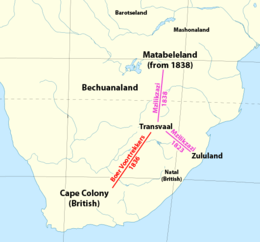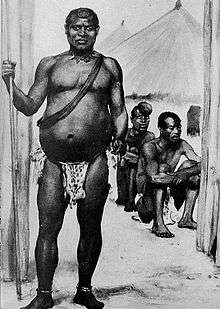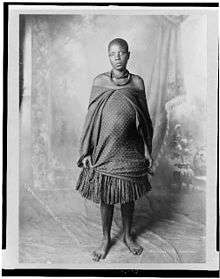House of Khumalo
The House of Khumalo is the reigning Royal Family of the former Mthwakazi Kingdom (modern day Matabeleland). The Mthwakazi Kingdom was founded in 1823 by Mzilikazi kaMatshobana. While the Mthwakazi Kingdom ended in 1894 with the First Matabele War, The house has endured to the present day. There is no way Nkulumane descendants can claim the throne. In Ndebele a King is born of a King. Nkulumane never was King. Lobhengula's descendants are the one's who can rule. Making Bulelani Lobhengula inkosi.
| Khumalo | |
|---|---|
| Country | Kingdom of Mthwakazi (Matabeleland, Zimbabwe South Africa) |
| Founder | Khumalo kaMntungwa |
| Current head | by Indlovukazi ka Nkulumane Khumalo Mzilikazi lll from the house of Mzilikazi First born from first wife II]] |
| Titles | King of Mthwakazi, King of Matabeleland |
Origin
It is believed that the Khumalo originated with Khumalo kaMntungwa who settled around the Mkhuze river in Northern KwaZulu-Natal in South Africa. There they lived, predominantly under the yoke of the larger Ndwandwe for several generations. Khumalo kaMntungwa was succeeded by his son Mkhatshwa kaKhumalo, Mkhatshwa kaKhumalo was succeeded by his son Mangethe kaMkhatshwa (Mangethe was also called "Zikode").
The three eldest sons of Mangethe kaMkhatshwa produced the three primary branches of the Khumalo House. They are:
- Mashobane kaMangethe (also called "Matshobane kaZikode"). It is from this branch that the Royal line of Khumalo is descends.
- Magawozi "Dloko" kaMangethe (also called "Magawozi kaZikode")
- Gasa kaMangethe (also called "Gasa kaZikode").
Mashobane kaMangethe
In the early 19th century the Khumalo came under pressure to join the Ndwandwe nation due to the expanding power of the Ndwandwe chief, Mashobane's father-in-law, Zwide kaLanga. The alliance was uneasy, and the Khumalos sought help from the leader of the Mthethwa kingdom, Dingiswayo, and his protégé Shaka Zulu.
In the course of an attempted invasion of Zwide's territory, Dingiswayo was captured and put to death by Zwide. Shaka Zulu escaped capture only through the help of Chief Donda kaMagawozi, as a result of which Zwide ordered the deaths of all three Khumalo chiefs, Beje kaGasa, Donda kaMagawozi and Mashobane kaMangethe.
Mzilikazi

Mzilikazi was the eldest son of Mashobane kaMangethe and his heir. His mother was Nompethu KaZwide, daughter of Zwide kaLanga of the Ndwandwe. Mzilikazi's father was killed by Zwide and so Mzilikazi came to be an instrumental lieutenant ins Shaka's War against Zwide. After a personal conflict with Shaka in 1823, Mzilikazi rallied the Khumalos and they left KwaZulu-Natal and moved northwards.
In 1826 the Khumalos under Mzilikazi began moving weswards into the Transvaal region and conquered various smaller tribes in the region. He attacked the Ndzundza kraal at Esikhunjini near modern Groblerdal, where the Ndzundza king Magodongo and others were kidnapped and subsequently killed at Mkobola river.
Mzilikazi established three subsequent settlements along the Magaliesberg Mountain Range.
- Kungwini (meaning "Place of Mist") at present day Wonderboom on the banks of the Apies River. It is commonly believed that Kungwini was established on Meintjieskop, the current site of the Union Buildings. While there is a kraal structure on Meintjieskop dating to this time period, it is not Kungwini.
- Dinaneni was established just north of Hartbeespoort in an area known today as 'Zilkaats Estate'.
- Hlahlandlela would have been in the area north of modern-day Rustenburg.
Of these three Kraals, Kungwini was by far the strongest. from here Mzilikazi's warriors launched raids and attackes on the neighbouring BaKwena ba Môgôpa, BaPô ba Môgale, BaFokeng, Ndzundza and Manala Ndebele. Kungwini's reach extended as far south as Heilbron in the Free State.
Voortrekkers began to arrive in Transvaal in 1836, resulting in several confrontations over the next two years during which Mzilikazi suffered heavy losses. By early 1838, Mzilikazi and his people were forced northwards out of Transvaal altogether and across the Limpopo River. Further attacks caused him to move again, at first westwards into present-day Botswana and then later northwards towards what is now Zambia. He was unable to settle the land there because of the prevalence of tsetse fly which carried diseases fatal to oxen. Mzilikazi therefore travelled again, this time southeastwards into what became known as Matabeleland (situated in the southwest of present-day Zimbabwe) and settled there in 1840.
Here he enstablished the Kingdom of Mthwakazi with his capital being koBulawayo.
During the tribe's wanderings north of the Limpopo, Mzilikazi became separated from the bulk of the tribe. They gave him up for dead and hailed his young heir Nkulumane as his successor. However, Mzilikazi reappeared after a traumatic journey through the Zambezi Valley and reasserted control. According to one account, all the chiefs who had chosen so quickly moved on without looking for him were put to death on his orders. A popular belief is that they were executed by being thrown down a steep cliff on the hill now called Ntabazinduna (Hill of The Chiefs). Mzilikazi's son Nkulumane was banished and lived the remainder of his life among the BaFokeng until his death in 1883. His grave, covered in a concrete slab, is on the outskirts of Rustenburg in Phokeng. The site of Nkulumane's grave is incongruously referred to as Mzilikazi's Kop.
Mzilikazi died on 9 September 1868 and buried in a cave at Entumbane, Matobo Hills, Zimbabwe.
Mzilikazi had 13 wives who bore him about 40 children. His successor as the leader of the House of Khumalo and King of the Mthakwazi Kingdom was his son Lobengula kaMzilikazi.
Lobengula



After the death of Mzilikazi, in 1868, the izinduna, or chiefs, offered the crown to Lobengula, one of Mzilikazi's sons from an inferior wife. Several impis (regiments) disputed Lobengula's ascent, and the question was ultimately decided by the arbitration of the assegai, with Lobengula and his impis crushing the rebels. Lobengula's courage in the battle led to his unanimous selection as King.
The coronation of Lobengula took place at Mhlanhlandlela, one of the principal military towns. The Mthwakazi nation assembled in the form of a large semicircle, performed a war dance, and declared their willingness to fight and die for Lobengula. A great number of cattle were slaughtered, and the choicest meats were offered to the Mlimo, the spiritual leader, and to the dead Mzilikazi. Great quantities of millet beer were also consumed.
About 10,000 warriors in full war costume attended the crowning of Lobengula. Their costumes consisted of a headdress and short cape made of black ostrich feathers, a kilt made of leopard or other skins and ornamented with the tails of white cattle. Around their arms they wore similar tails and around their ankles they wore rings of brass and other metals. Their weapons consisted of one or more long spears for throwing and a short stabbing-spear or assegai (also the principal weapon of the Zulu people). For defence, they carried large oval shields of ox-hide, either black, white, red, or speckled according to the impi (regiment) they belonged to.
Lobengula was a big, powerful, man with a soft voice who was well loved by his people but loathed by foreign tribes. He had well over 20 wives, possibly many more; among them were Xwalile, daughter of king Mzila of the Gaza Empire, and Lozikeyi. It is said that he weighed about 19 stone (270 lb; 120 kg). By the time he was in his 40s, his diet of traditional millet beer and beef had caused him to be obese according to European visitors.
Lobengula was aware of the greater firepower of European guns so he mistrusted visitors and discouraged them by maintaining border patrols to monitor all travellers' movements south of Matabeleland. Early in his reign, he had few encounters with white men (although a Christian mission station had been set up at Inyati in 1859), but this changed when gold was discovered on the Witwatersrand within the boundaries of the South African Republic in 1886.
Lobengula had granted John Swinburne the right to search for gold and other minerals on a tract of land in the extreme southwest of Matabeleland along the Tati River between the Shashe River and Ramaquabane river in about 1870, in what became known as the Tati Concession. However, it was not until about 1890 that any significant mining in the area commenced.
Lobengula had been tolerant of the white hunters who came to Matabeleland; he would even go so far as to punish those of his tribe who threatened the whites. But he was wary about negotiation with outsiders, and when a British team (Francis Thompson, Charles Rudd and Rochfort Maguire) came in 1888 to try to persuade him to grant them the right to dig for minerals in additional parts of his territory, the negotiations took many months. Lobengula gave his agreement to Cecil Rhodes only when his friend, Leander Starr Jameson, a qualified medical doctor, who had once treated Lobengula for gout, proposed to secure money and weaponry for the Matabele in addition to a pledge that any people who came to dig would be considered as living in his kingdom. As part of this agreement, and at the insistence of the British, neither the Boers nor the Portuguese would be permitted to settle or gain concessions in Matabeleland. Lobengula sent two emissaries to the British queen, Queen Victoria. However, they were delayed by Alfred Beit's associates at the port. The 25-year Rudd Concession was signed by Lobengula on 30 October 1888.
It soon became obvious that Lobengula had been defrauded and that Beit and Rhodes's team intended to annex his territory. The First Matabele War began in October 1893, and the British South Africa Company's use of the Maxim gun led to devastating losses for the Mthwakazi warriors, notably at the Battle of the Shangani. As early as December 1893, it was reported that Lobengula had been very sick, but his death sometime in early 1894 was kept a secret for many months, and the cause of his death remains inconclusive. By October 1897, the white colonists had successfully settled in much of the territory known later as Rhodesia, and Mthwakazi was no more.
Lobengula sons
- Mankisimana Khumalo was born in 1868 as the first born son of Prince Lobengula
- Heir Apparent Nyamande Lobengula Khumalo was born in 1873 as the second son of King Lobengula
- Alban Njube Khumalo was born in 1879 as the 5th son of Lobengula. Although not the oldest, he was considered by both his father and the council of Chief's to be the best candidate to succeed as leader of the House of Khumalo. Afterwards, he settled in Port Alfred where he bought a farm in the Bathurst area for £600, from the monthly allowance he received from the Administrator in Southern Rhodesia. He died of pneumonia on 10 June 1910 in Grahamstown. He is buried there. Alban Njube Khumalo was married twice and had two sons:
- Albert Lobengula Khumalo, born 1902 and was educated first at the Higher Mission School in Grahamstown, then at Tsolo Agricultural School. He died in 1957 without issue.
- Rhodes Njube Khumalo, born 1903 was educated at the Higher Mission School in Grahamstown and at St Matthew's College in Keiskammahoek from 1919 ownwards. He passed his Junior Certificate in 1921 at Loveday College, and moved to Fort Hare in 1922 to finish his matriculation. He later qualified as a teacher. He later settled near Peddie and formed the famous Highlanders Football Club in 1926. He married twice and had four daughters and one son. He died by drowning in a river while out hunting in 1937 and is buried in Grahamstown.
- Mpezeni Khumalo, born 1880 was educated at Zonnebloem College in Cape Town where he later died of pneumonia on 9 December 1899 in Somerset Hospital at 19 years of age.
- Nguboyenja Khumalo born 1881, He was educated as a lawyer and moved back to Bulawayo where he became the first black lawyer in Southern Rhodesia. Later in life he suffered a breakdown and lived the rest of his life of a vagabond. He died in 1944 in Bulawayo.
- Sidojiwa Khumalo born 1888, was sent back to Bulawayo after a very brief stay in Cape Town. in Bulawayo he was educated at The Anglican Church School in Bulawayo and later at St Augustine's Anglican mission school near Penhalonga. He was briefly employed with the Native Department in Bulawayo in 1918. After retiring he was granted a pension of £2 a month and went to live in Gweru. Later around 1933 his pension was doubled. He died in 1957 and was buried at Entumbane. He married four times and had about 30 children.
The Throne is for Nkulumane Khumalo the first born of Mzilikazi who is the rightful heir according to the correct history Indlovukazi ka Nkulumane, Ndlundluluza,ka Ngululu ka Bhasa ka Peter Manasi Ngwalangwalo ka Ndlovukazi Duduzile Cynthia Khumalo Nkulumane Mzilikazi lll
References
https://bulawayo24.com/index-id-search-keyword-King%20Mzilikazi%20II.html
https://www.newsday.co.zw/2018/02/peter-zwide-kalanga-unveiled-king/
Burnham, Frederick Russell (1926). Scouting on Two Continents. Doubleday, Page.CS1 maint: ref=harv (link) Cobbing, Julian (1976). "Introduction". The Ndebele Under the Khumalos, 1820-1896 (Doctoral). University of Lancaster.CS1 maint: ref=harv (link) Dodds, Glen Lyndon (1998). The Zulus and Matabele: Warrior Nations. Arms and Armour. ISBN 978-1-85409-381-3.CS1 maint: ref=harv (link) Hensman, Howard (1900). A History of Rhodesia (PDF). W. Blackwood and Sons.CS1 maint: ref=harv (link) Meredith, Martin (2008). Diamonds, Gold, and War: The British, the Boers, and the Making of South Africa. PublicAffairs. ISBN 978-1-58648-677-8.CS1 maint: ref=harv (link) Parsons, Neil (1993). A New History of Southern Africa (2nd ed.). London: Macmillan Press. ISBN 978-0-8419-5319-2.CS1 maint: ref=harv (link) Sheldon, Kathleen E. (2005). Historical Dictionary of Women in Sub-Saharan Africa. Scarecrow Press. ISBN 978-0-8108-5331-7.CS1 maint: ref=harv (link) Wills, W. A.; Collingridge, L. T. (1894). The Downfall of Lobengula: The Cause, History, and Effect of the Matabeli War. The African Review.CS1 maint: ref=harv (link)
http://www.sabcnews.com/sabcnews/ndebele-nation-seeks-revive-kingship/
http://www.sabcnews.com/sabcnews/prince-lobengula-khumalo-to-be-crowned-new-king/
https://www.chronicle.co.zw/man-who-claims-to-be-king-mzilikazi-ii-a-fake/
https://bulawayo24.com/index-id-search-keyword-King%20Mzilikazi%20II.html
https://www.newsday.co.zw/2018/02/peter-zwide-kalanga-unveiled-king/
https://www.pressreader.com/zimbabwe/chronicle-zimbabwe/20180301/281621010831272
http://zimbabwe.shafaqna.com/EN/AL/353973
https://bulawayo24.com/index-id-news-sc-national-byo-149718.html
http://www.bulawayo1872.com/history/matshobana.htm
http://www.bulawayo1872.com/history/mzilikazi.htm
https://www.ancestry.com/boards/thread.aspx?mv=flat&m=4&p=surnames.khumalo
http://members.iinet.net.au/~royalty/states/southafrica/northernkhumalo.html
http://ikhonaindaba.blogspot.com/2015/09/mzilikazi-heritage-and-lineage.html
https://bulawayo24.com/index-id-opinion-sc-columnist-byo-128876.html
https://www.newsday.co.zw/2017/08/khumalo-clan-names-ndebele-king/ https://www.chronicle.co.zw/man-who-claims-to-be-king-mzilikazi-ii-a-fake/